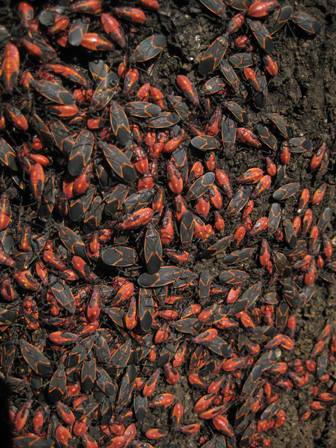K Thomas Lawson is proud to be a division of Bartlett Tree Experts, and our staff now has the backing of an international tree-care company and tree research laboratory to help continue providing excellent tree service and shrub care in the Charlottesville, Virginia area. View a complete list of professional tree services offered by Bartlett.
Box Elder Bugs are tree pests especially in the fall
This is a swarm of box elder bugs, Boisea trivittata on a box elder trunk in late October. They are congregating on the warm, sunny, southern side of the old trunk in the afternoon. They don’t bite, but these tree pests can be a nuisance since they fly upon approach (they have good eyesight) and they seek shelter in the cracks and crevices of doors and windows on homes and vehicles.

- Trees commonly affected:
Box Elder, a type of maple,Acer negundo, - Silver Maple, Acer saccharinum,
- Ash, Fraxinus species.
Solution: We encourage a live and let live attitude for these tree pests. If you can live with them nearby, do so. If the tree is ailing and old, removing the tree will lessen the congregation sites for the bugs. They may find another suitable host close by.
Considered non-toxic to humans, a dusting of Boric acid will deter them from window areas and door crevices.
Life Cycle of Box Elder Bugs makes them Tree Pests
In the spring they may weaken the tree by feeding on the softer plant tissues, including the flowers, new leaves, new twigs. However, there may not be visible signs of eating damage. Only a huge infestation will result in permanent damage to a tree. A crop of eggs are laid and nymphs hatch a few days later. Nymphs are brighter red and can reproduce in the same year. In summer, they go about their business, eating and mating.
In the late summer and fall, the mature box elder bugs are moving to new locations where they will hide in a protective location to overwinter. You may see them under siding, or tucked into the crevices of your storm windows. This is when you may notice them in large numbers. There can be two or three generations alive together in a colony through the fall. Once winter sets in, adults are the only ones to survive. Recurring populations may cumulatively damage a tree over years.
Contact your local extension office to learn more about your local tree pests
Leave Tree Pests and go back to Tree Problems
Homepage www.Arborist-treecare.com
